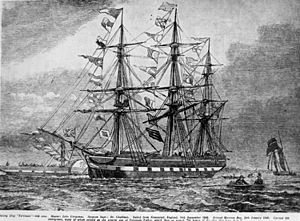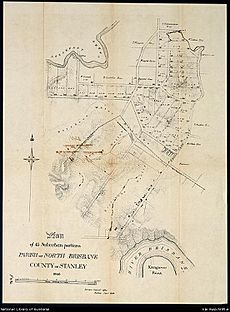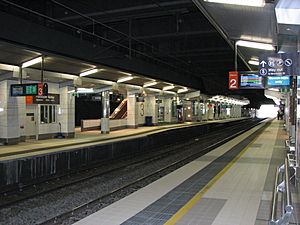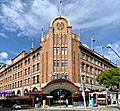Fortitude Valley, Queensland facts for kids
Quick facts for kids Fortitude ValleyBrisbane, Queensland |
|||||||||||||||
|---|---|---|---|---|---|---|---|---|---|---|---|---|---|---|---|

Retail and restaurants in Fortitude Valley
|
|||||||||||||||
| Population | 6,978 (2016 census) | ||||||||||||||
| • Density | 4,980/km2 (12,900/sq mi) | ||||||||||||||
| Postcode(s) | 4006 | ||||||||||||||
| Area | 1.4 km2 (0.5 sq mi) | ||||||||||||||
| Time zone | AEST (UTC+10:00) | ||||||||||||||
| Location | 1.6 km (1 mi) NE of Brisbane CBD | ||||||||||||||
| LGA(s) | City of Brisbane (Central Ward) |
||||||||||||||
| County | Stanley | ||||||||||||||
| Parish | North Brisbane | ||||||||||||||
| State electorate(s) | McConnel | ||||||||||||||
| Federal Division(s) | Brisbane | ||||||||||||||
|
|||||||||||||||
Fortitude Valley (often called "The Valley" by local residents) is an inner suburb of the City of Brisbane, the state capital of Queensland, Australia. In the 2016 census, Fortitude Valley had a population of 6,978 people. The suburb features two pedestrian malls at Brunswick Street Mall and Chinatown.
Contents
History
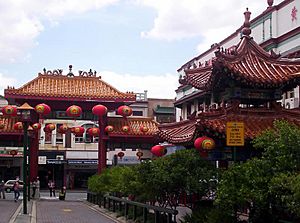
Scottish immigrants from the ship SS Fortitude arrived in Brisbane in 1849, enticed by Rev Dr John Dunmore Lang on the promise of free land grants. Denied land, the immigrants set up camp in York's Hollow waterholes in the vicinity of today's Victoria Park, Herston, Queensland. A number of the immigrants moved on and settled the suburb, naming it after the ship on which they arrived. A post office was established in 1887.
1891 saw the train line extended from the Brisbane central business district (the area around Queen Street) into Fortitude Valley, and Thomas Beirne opened a business on Brunswick Street. His business thrived and, after extension, he travelled to England in 1896, leaving his manager of two years, James McWhirter, in charge. Soon after his return, McWhirter established a competing drapery business opposite Beirne's in 1898. Beirne and McWhirter became keen rivals and are credited with establishing the Valley as a hub of commerce from the late 1890s.
In the late 19th century, commercial activities in Brisbane were divided along religious lines, with Protestant shopkeepers setting up along Queen and Adelaide Streets in the central business district, and shops operated by Roman Catholics in Stanley Street, South Brisbane. However, in the 1893 Brisbane flood (and again in 1897), major floods wiped out many shops in South Brisbane, and owners in that area decided to move and set up operations north of the river in an area free of flooding. The area they chose was Fortitude Valley. By that time Brisbane's horse-drawn tram system already centered on Fortitude Valley, making it the logical choice to establish a shopping precinct.
Fortitude Valley was also strongly advocated as the location of a new town hall in what became known as "the battle of the sites". Brisbane Town Council already purchased a piece of land in Fortitude Valley and supporters of the Fortitude Valley site pointed out that it would allow stronger foundations compared to the swampy site proposed at Adelaide Street in the existing commercial district. However, a petition was raised in support of the Adelaide Street site and with the support of Charles Moffatt Jenkinson, the mayor of Brisbane in 1914, it was chosen over the Fortitude Valley site. Jenkinson committed the council to that decision by selling the site in Fortitude Valley to the Catholic Church for the construction of the Holy Name Cathedral (a project that, although commenced, made little progress and was eventually abandoned).
From the early 1900s through to the 1960s, the thriving shopping precinct was dominated by McWhirters, Beirne's and, later, Overells' department stores. The Overells Building was completed in 1907. They were ultimately bought out by the Myer, David Jones and Waltons chains respectively with Overells being bought by Walton in 1956. Woolworths and Coles supermarkets and a host of smaller shops also flourished in the precinct during this period. Owing to its proximity to the central business district and the close concentration of public transport in the area, the Valley became the largest non-CBD shopping precinct in Australia through the 1950s and 1960s.
The rise of suburban shopping centres and the closure of the tram network in 1969 sounded the death knell for Fortitude Valley, with a gradual decrease in customers. David Jones closed its Valley store in the 1970s and Myer closed its doors in the early 1990s, and the once-thriving commercial centre devolved to dilapidation. In the 1970s and 1980s, the area fell into disrepute and, with the tacit support of police and government and illegal gambling houses set up shop.
Transport
Brisbane Transport operates buses to, from and through Fortitude Valley. Fortitude Valley railway station serves all suburban and interurban lines, including Airport line service to Brisbane Airport. The station has four platforms and is located in Zone 1 of the TransLink integrated public transport system.
Taxis
Secure taxi ranks to enable patrons to catch a taxi home are set up at various strategic points and enable easy access without the need to hail a cab. Fortitude Valley has five locations with these ranks on Friday and Saturday night. Funding for this free service is provided by the Brisbane City Council, the Queensland State Government and the Taxi Council of Queensland. These secure ranks are manned by taxi supervisors and security guards to ensure commuters an orderly and safe environment whilst they wait for service.
Speed limits
On 24 August 2007, a 40 km/h (25 mph) speed limit was introduced to parts of Wickham Street, Ann Street, McLachlan Street and Warner Street. The speed limit applies between 10 pm and 6 am from Friday to Sunday night. The speed limit was introduced following safety audits of the Fortitude Valley identifying pedestrian-vehicle conflict as a major issue.
Population statistics
In the 2011 census, the population of Fortitude Valley was 5,615 people: 42.9% female and 57.1% male. The median age of the Fortitude Valley population was 31 years, 6 years below the Australian median. Children aged under 15 years made up 3.8% of the population and people aged 65 years and over made up 5.9% of the population. 50.1% of people living in Fortitude Valley were born in Australia, compared to the national average of 69.8%; the next most common countries of birth were New Zealand 4.5%, England 4.1%, China 2.2%, Ireland 1.8%, Republic of Korea 1.3%. 65.1% of people spoke only English at home; the next most popular languages were 2.4% Mandarin, 2.2% Cantonese, 2% Spanish, 1.1% Korean, 1.1% Japanese. The most common religious affiliation was "No Religion" (31.7%); the next most common responses were Catholic 22.7%, Anglican 8.8%, Buddhism 3.7% and Uniting Church 2.0%.
Heritage listings
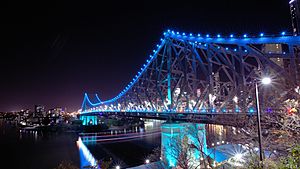
Fortitude Valley has a number of heritage-listed sites, including:
- 112 Alfred Street: Fortitude Valley Child Health Centre
- 501 Ann Street: Queensland Brewery Company Building
- 547 Ann Street: All Hallows' School Buildings
- 740 Ann Street: former Fortitude Valley Post Office
- 33 Arthur Street: Doggetts Cottage
- Boundary Street: Howard Smith Wharves
- 95 Boundary Street: Austral Motors Building
- Bradfield Highway: Story Bridge
- 95 & 99 Brookes Street: Fortitude Valley State School including the former Fortitude Valley Infants' School and former Fortitude Valley Boys' School
- 116-120 Brookes Street: Fortitude Valley Methodist Church
- 119 Brookes Street: Fortitude Valley Police Station
- 141 Brookes Street: Holy Trinity Church
- 141 Brookes Street: Holy Trinity Parish Hall
- 141 Brookes Street: Holy Trinity Rectory
- 323-335 Brunswick Street: Royal George Hotel and Ruddle's Building
- 339 Brunswick Street: Empire Hotel
- 446-452 Brunswick Street: former Corbett and Son Store
- 483 Brunswick Street: Fortitude Valley Primitive Methodist Church
- 517 Brunswick Street: La Scala
- 28 Duncan Street: TC Beirne Department Store
- Gipps Street: Holy Name Cathedral Site
- 9 McLachlan Street: Bulolo Flats
- 58 Morgan Street: St Patricks Church
- 167-173 St Paul's Terrace: Villa Maria Hostel
- 464-468 St Paul's Terrace: Jubilee Hotel
- 342 Water Street: Drill Shed
- Wickham Street: McWhirters
- 85 Wickham Street: Centenary Place
- 230 Wickham Street: Prince Consort Hotel
- 308 Wickham Street: Wickham Hotel
Education
Angelorum College is a private primary and secondary (Prep-9) school for boys and girls at 377 St Pauls Terrace (27°27′20″S 153°01′58″E / 27.4556°S 153.0327°E). In 2017, the school had an enrolment of 35 students with 4 teachers and 3 non-teaching staff (2 full-time equivalent).
Music Industry College is a private secondary (11-12) school for boys and girls at 38-42 Berwick Street (27°27′32″S 153°02′13″E / 27.4588°S 153.0369°E). In 2017, the school had an enrolment of 80 students with 7 teachers (5 full-time equivalent) and 6 non-teaching staff (4 full-time equivalent).
There are no government primary schools in Fortitude Valley; the nearest government primary schools are Brisbane Central State School (in Spring Hill) and New Farm State School (in New Farm).
All Hallows' School is a Catholic faith based private school in Fortitude Valley. It is said to be Queensland's oldest secondary school.
There were no government secondary schools in Fortitude Valley (the nearest was Kelvin Grove State College) until the start of 2020 when the new Fortitude Valley State Secondary College opened.
Notable people
- Edward Archibald Douglas (1877–1947)
- Born on 2 November and attended St. Benedict's College, Fort Augustas
- Appointed judge of the Industrial Court of Queensland in 1915 by T. J. Ryan's Labor Government
- Appointed Supreme Court Judge in 1929 until his death in 1947 from a coronary occlusion
- Harriette Martha Voss (1887–1951)
- Born on 10 October and attended Brisbane Girls Grammar School and the University of Sydney
- Appointed resident medical officer upon graduation and in March 1915 she was appointed Chief R.M.O.
- In 1948, Voss became the manager of Hillcrest Hospital but was forced to resign in 1951 due to ill health
- She died on 20 December later that year with her final wish of Hillcrest Hospital being attained by St. Andrew's Presbyterian Church
- Charles Edward Chuter (1880–1948)
- Born 11 March, Chuter attended Fortitude Valley Primary School and later on Brisbane Grammar School on scholarship
- July 1898, he joined the Home Secretary's Department as clerk until 1922 when he was prompter assistant under-secretary of the Home Secretary's Department
- Chuter retired 31 December 1947 and passed from a coronary occlusion 31 January 1948
Images for kids
-
McWhirters Marketplace



